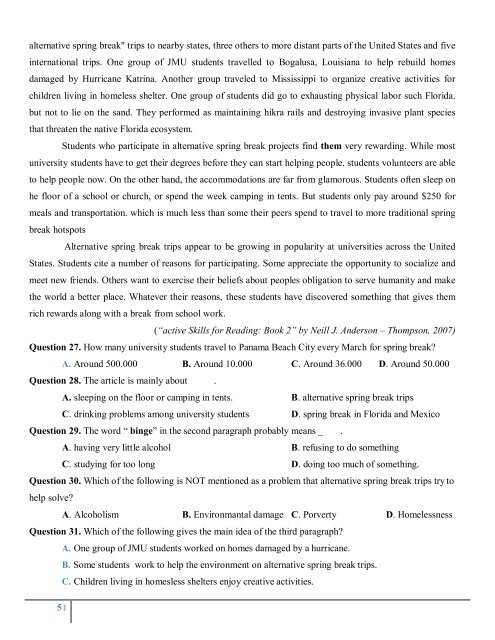12 đề thi thử THPT Quốc gia môn tiếng Anh năm 2018 có lời giải chi tiết
https://app.box.com/s/nnfa5e7e8wjt4ogw5c12nscparzxshyv
https://app.box.com/s/nnfa5e7e8wjt4ogw5c12nscparzxshyv
Create successful ePaper yourself
Turn your PDF publications into a flip-book with our unique Google optimized e-Paper software.
alternative spring break" trips to nearby states, three others to more distant parts of the United States and five<br />
international trips. One group of JMU students travelled to Bogalusa, Louisiana to help rebuild homes<br />
damaged by Hurricane Katrina. Another group traveled to Mississippi to organize creative activities for<br />
<strong>chi</strong>ldren living in homeless shelter. One group of students did go to exhausting physical labor such Florida.<br />
but not to lie on the sand. They performed as maintaining hikra rails and destroying invasive plant species<br />
that threaten the native Florida ecosystem.<br />
Students who participate in alternative spring break projects find them very rewarding. While most<br />
university students have to get their degrees before they can start helping people. students volunteers are able<br />
to help people now. On the other hand, the accommodations are far from glamorous. Students often sleep on<br />
he floor of a school or church, or spend the week camping in tents. But students only pay around $250 for<br />
meals and transportation. which is much less than some their peers spend to travel to more traditional spring<br />
break hotspots<br />
Alternative spring break trips appear to be growing in popularity at universities across the United<br />
States. Students cite a number of reasons for participating. Some appreciate the opportunity to socialize and<br />
meet new friends. Others want to exercise their beliefs about peoples obligation to serve humanity and make<br />
the world a better place. Whatever their reasons, these students have discovered some<strong>thi</strong>ng that gives them<br />
rich rewards along with a break from school work.<br />
(“active Skills for Reading: Book 2” by Neill J. Anderson – Thompson, 2007)<br />
Question 27. How many university students travel to Panama Beach City every March for spring break?<br />
A. Around 500.000 B. Around 10.000 C. Around 36.000 D. Around 50.000<br />
Question 28. The article is mainly about .<br />
A. sleeping on the floor or camping in tents. B. alternative spring break trips<br />
C. drinking problems among university students D. spring break in Florida and Mexico<br />
Question 29. The word “ binge” in the second paragraph probably means _ .<br />
A. having very little alcohol B. refusing to do some<strong>thi</strong>ng<br />
C. studying for too long D. doing too much of some<strong>thi</strong>ng.<br />
Question 30. Which of the following is NOT mentioned as a problem that alternative spring break trips try to<br />
help solve?<br />
A. Alcoholism B. Environmantal damage C. Porverty D. Homelessness<br />
Question 31. Which of the following gives the main idea of the <strong>thi</strong>rd paragraph?<br />
A. One group of JMU students worked on homes damaged by a hurricane.<br />
B. Some students work to help the environment on alternative spring break trips.<br />
C. Children living in homesless shelters enjoy creative activities.<br />
5

















